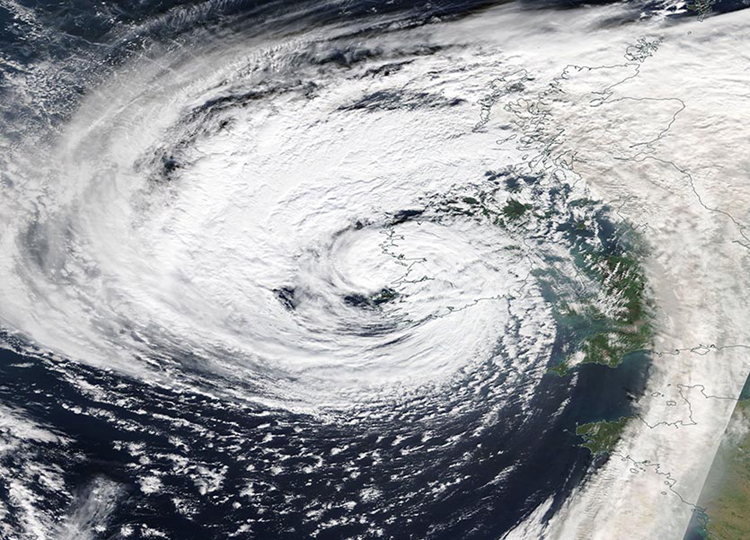On Monday, October 16, tropical storm Ophelia roared through the northeastern Atlantic Ocean, killing three people in Ireland and causing damage in parts of the United Kingdom. Ophelia, one of the most powerful storms ever recorded in that part of the Atlantic, was an unusual occurrence. The last such storm to reach Ireland, Hurricane Debbie, killed 11 people on the island in 1961.
Major Atlantic storms typically form in waters off the central and southern coasts of west Africa. Trade winds then carry them westward toward the Caribbean Sea and the southeastern United States. Ophelia began as a cluster of storms farther north, gathering strength near the Azores before driving northeast toward Europe. Classified as a mid-strength Category 3 hurricane, Ophelia was the strongest-ever storm that far east in the Atlantic Ocean. Downgraded to a tropical storm on its jet stream-led course to Ireland, Ophelia remained dangerous. Ireland’s national weather service issued a red alert for severe weather, warning of “violent and destructive gusts” and “potential loss of life.”

The storm made landfall in Ireland on Monday morning with wind gusts of 109 miles (176 kilometers) per hour at Fastnet Rock, the country’s most southerly point. Torrential rains lashed the southwestern counties of Cork and Kerry, where schools, businesses, public buildings, and hospitals were closed ahead of the storm. Public transportation ceased running in much of Ireland, ferries and flights were canceled, and people were warned to stay indoors.
Ophelia quickly swamped all of the Republic of Ireland, whipping Wales hard too across the Irish Sea. Electric power was lost in many areas of both Ireland and Wales, trees were blown down (causing all three of the deaths in Ireland), rooftops were ripped away, and storm surges breached sea walls in many places. Winds and heavy rains then hit Northern Ireland and Scotland as Ophelia raced back out to sea, dissipating but still carrying severe weather as far as Norway. (The United Kingdom is divided among the political divisions of Wales, Northern Ireland, Scotland, and England.)
Ophelia affected other areas, too. In Portugal and Spain, strong winds from the storm fanned wildfires that killed 44 people. Ophelia blew smoke from the fires—and dust from Sahara sandstorms—over England, where the London sky turned an eerie smoky orange. Ophelia was the 10th hurricane of a busy and deadly 2017 Atlantic storm season. Ophelia’s rare path illustrates how rising global temperatures are expanding the range of powerful storms around the world.
Untitled Document
Can't view the linked articles? Subscribe to World Book Online

World Book Online delivers a progressive sequence of core databases supported by supplemental
tools, such as language translation, graphic organizers, and unique Webquests. Moving from
Early World of Learning to World Book Advanced, World Book Online aligns end-users with their
appropriate learning levels. Each stand-alone site provides additional features to support the
needs of users’ specific capabilities.
The World Book Difference
World Book combines cutting-edge technology with traditional editorial excellence to produce
authoritative, trustworthy, and unbiased content. The digital content is updated in real time and
carefully curated for each learning level. Accessible 24/7, the content is available on a variety of devices.
World Book Online combines 21st-century instructional techniques with timely information.
By breaking down complex topics and using easily understandable text, World Book Online helps to
build fluency and increase comprehension. Featuring single sign-on capability, these sites are paired
with highly visual content to engage even the most reluctant reader. Our collection of resources kindles
a lifelong learning experience for every user. This adherence to clarity, currency, and accuracy makes
World Book’s digital offerings an information hub for the classroom, library, and beyond.
Image 1: Tropical storm Ophelia slammed the coasts of Ireland and Wales on Oct. 16, 2017. This photo shows Ophelia-driven waves battering the sea wall at Porthcawl in southern Wales. Credit: © Leighton Collins, Shutterstock
Image 2: This satellite image shows Ophelia coiling over Ireland on Oct. 16, 2017. Credit: NASA